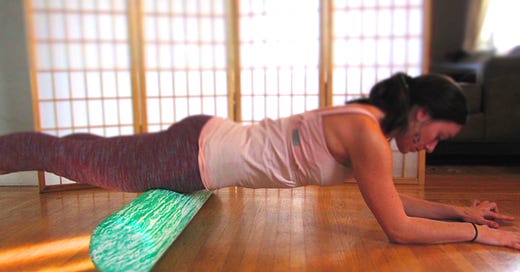Why Swapping One Workout for Foam Rolling Could Make You Stronger
I mean, I'd kinda bet my life on it.
In my day-to-day as a Fascial Stretch Therapist, whenever I ask my clients if they foam roll between sessions, the response is almost always the same: a guilty “not really,” followed by a list of excuses. Let me be clear: this guilt is self imposed. I am NOT in the business of shaming anyone for how they treat their bodies—I instead really want to celebrate you just having one that you’re respecting as best you can. But here’s the interesting thing I’ve noticed—most of those who actively work with their bodies aren’t skipping foam rolling because they don’t have time. We’re skipping it because we don’t see it as valuable. Believe it or not, I get caught in this cycle, too.
We’ve been conditioned to believe that exercise = health. We prioritize the sweat, the burn, the feeling of accomplishment that comes from pushing ourselves. But what we rarely talk about is the price we pay when we don’t balance all that effort with recovery.
Foam rolling isn’t just a supplement to your workouts—it could be the missing link that makes all your other movement better. If we replaced just one workout per week with a slow, intentional hour of rolling, we’d return to our workouts stronger, more mobile, and with fewer aches slowing us down. Here’s why:
1. Foam Rolling Keeps You Functional
Being “fit” isn’t just about lifting heavy weights or running long distances. It’s about how well your body moves in daily life.
Sitting too long? Your joints get stiff, and your circulation slows down.
Lifting something heavy? Your muscles tighten to compensate, but without release, that tension builds up.
The simple act of foam rolling isn’t easy. You’re supporting yourself with one part of you while trying to create utter ease in another part of you. You’re also challenging yourself to absorb TONS of sensation from the roller. A foam rolling practice loads and moves your joints in a way that keeps them available to you. Instead of just stretching, which targets muscles in a passive way, rolling actively hydrates the fascia, stimulates blood flow, and encourages better movement patterns—so you don’t feel like the Tin Man every time you get up from your desk. It’s a gentle workout for all your tissues in and of itself.
2. Foam Rolling Keeps You Strong
Strength isn’t just about how much you lift—it’s also about how well you support your own body.
Rolling requires you to balance, stabilize, and activate multiple muscle groups at once. When you roll one part of your body, another part is working to hold you up. If done intentionally, this creates the perfect balance:
Enough muscle activation to maintain strength
Enough ease to avoid burnout
Enough repetition to create lasting neuromuscular connections
A body that gets no activation atrophies. A body that gets too much burns out. But a body that finds just enough? That’s a sweet spot worth aiming for.
3. Foam Rolling Supports Mental and Emotional Well-Being
Let’s talk about what happens when we hold on to tension—not just in our muscles, but in our nervous system.
Foam rolling is a form of self-myofascial release (SMR), which means it doesn’t just work on a mechanical level. It has profound psychological benefits, too:
Reduces stress and anxiety – Rolling can help shift the body into a more parasympathetic state (aka, “rest and digest”), counteracting the high cortisol levels that come from chronic stress and overtraining.
Enhances relaxation and well-being – The act of compressing and releasing tissues sends signals to the brain that it’s safe to let go, creating a sense of physical and mental ease.
Improves mood – Just like massage, rolling stimulates sensory receptors that can boost endorphin levels and promote a feeling of lightness.
Essentially, foam rolling isn’t just a tool for relieving muscle tightness—it’s a tool for resetting your entire system. And when your body feels better, your mind follows.
What If You Traded One Workout for Rolling?
Instead of seeing foam rolling as something you “should” do but don’t have time for, what if you made it a priority—just like your workouts?
What if, once a week, you swapped a high-intensity sweat session for an hour of deep, intentional recovery?
My guess? You’d come back to your workouts stronger, move through your day with less tension, and start feeling more at home in your body. I dare you to try it. ;)
Wanna see for yourself? I’ve got on-demand rolling classes between 3—60 minutes that will walk you through exactly how to do it. Browse the rolling library! Grab a one-time masterclass or sign up for weekly classes and see what a difference it makes. Your first 7 days are FREE through my Patreon platform!
We just finished our 4-week live class series here in Oakland and I witnessed (and experienced) ALL of the above. It feels so great to roll for an hour and I can’t tell you how many times I’ve heard “I can’t believe it’s over! It just flew by!” With the proper guidance in a class, you’ll wonder why classes aren’t two hours long, either.
Love,
Maggie 💛





This is super helpful in understanding the benefits of foam rolling. Lord knows I definitely need more time in a parasympathetic state!